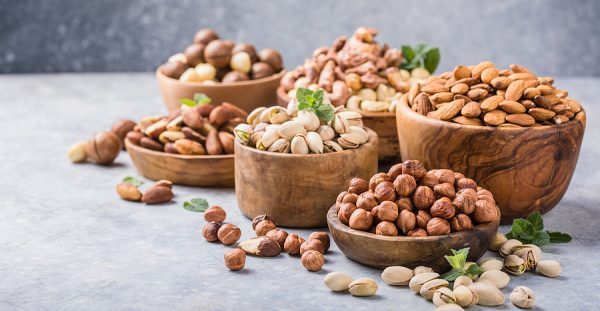By David Blyweiss, M.D., Advanced Natural Wellness
I know people who have tried to go on a raw food diet. And I realize how appealing the concept is. It sounds so “clean” to get living food enzymes and nutrients from raw food. And it is!
Raw fruits, veggies, nuts and seeds are loaded with digestive enzymes and antioxidants. When you eat raw, organic vegetables instead of those that are cooked, you get more firm fiber, which is going to make your gut microbiome healthier.
This makes a raw diet especially appealing if you need to lose weight, since fiber can help you feel full longer so that you eat less. And a more balanced microbiome is great for your health.
Some raw food diets include eating raw animal products. I don’t recommend that, even if you’re a sushi lover. Eating raw meat, poultry and fish is downright dangerous. I stopped eating sushi after I saw parasitic worms in the fish I was eating…yuck.
But no matter how you look at it, sticking with a diet of mostly raw, unprocessed foods is extremely hard to sustain over the long-term. So I think people should get their vegetables any way they can.
Cooking can Release Vital Nutrients
Here’s the deal…
A whopping 9 out of every 10 American adults do not eat the recommended two to three cups of vegetables each day. Yes, you read that correctly. The majority of adults aren’t eating their veggies.
That’s unfortunate, because plant-based foods are one of the cornerstones of health. They are loaded with super-powerful antioxidants that fight disease and help you live longer.
Take broccoli. It contains sulforaphane, which can turn on tumor inhibitor genes. This explains why cruciferous vegetables like broccoli, kale, cauliflower, radishes and cabbage are such potent cancer fighters.
And while overcooking foods like broccoli will destroy some nutrients and enzymes, if you cook the food correctly, it can release them.
For example, all it takes to increase the sulforaphane content in broccoli by up to 237% is to blanche it. Chopping broccoli before cooking also helps release sulforaphane in broccoli.
You can tell when your broccoli is blanched properly because it will turn a bright emerald green. (If you cook it too long and it turns into a mushy olive green color, you’ve likely lost a lot of the nutrient content and it won’t taste very good.)
Tomatoes are another perfect example. Cooking releases the lycopene found in these juicy red fruits. In fact, after cooking, the total antioxidant activity in a tomato can increase by as much as 62%. And it has a much higher lycopene content. This may explain why about three-quarters of people who eat a raw food diet have low levels of this cancer-fighting antioxidant.
So you see, the nutrient content in some foods is actually enhanced by cooking.
What’s the Verdict: Raw or Cooked?
Ultimately, I don’t think you should choose either a completely raw or a completely cooked diet.
Instead, I recommend eating one raw, organic, plant-based meal each day. But I’m not talking about throwing a little wilted lettuce on a plate and drenching it with bottled dressing. There are much healthier options.
One of my go-to meals is a variety of crunchy, raw vegetables with hummus and tabouleh. The burst of flavor is reason enough to eat a meal like this… it’s also extremely nutritious and quite filling.
Or you can chop up a mix of your favorite raw veggies and drizzle them with garlic-infused extra virgin olive oil. Add nuts, herbs and spices for more flavor and texture.
And you can’t go wrong with a veggie wrap. Slice up some cucumber, avocado, spinach, tomatoes and other veggies and wrap them up in a nice, big lettuce leaf.
Then, during regular meals, skip the boiling and frying.
Instead, blanche your veggies or give them a light steam. Toss them briefly in a wok or give them a quick blast of heat under the broiler. This will be just enough to release compounds that are enhanced during the cooking process, without robbing your veggies of their naturally occurring nutrients.
Between meals, snack on a variety of fruits and nuts to help round out your nutritional profile.
SOURCES:
Lee SH, Moore LV, Park S, Harris DM, Blanck HM. Adults Meeting Fruit and Vegetable Intake Recommendations — United States, 2019. MMWR Morb Mortal Wkly Rep. 2022;71:1–9.
Pérez C, Barrientos H, Román J, Mahn A. Optimization of a blanching step to maximize sulforaphane synthesis in broccoli florets. Food Chem. 2014 Feb 15;145:264-71.
Dewanto V, Wu X, Adom KK, Liu RH. Thermal processing enhances the nutritional value of tomatoes by increasing total antioxidant activity. J Agric Food Chem. 2002 May 8;50(10):3010-4.
Garcia AL, Koebnick C, Dagnelie PC, Strassner C, Elmadfa I, Katz N, Leitzmann C, Hoffmann I. Long-term strict raw food diet is associated with favourable plasma beta-carotene and low plasma lycopene concentrations in Germans. Br J Nutr. 2008 Jun;99(6):1293-300.






